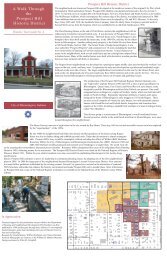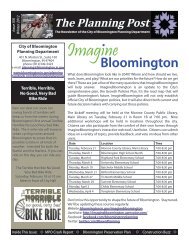Peak Oil Task Force Report - City of Bloomington - State of Indiana
Peak Oil Task Force Report - City of Bloomington - State of Indiana
Peak Oil Task Force Report - City of Bloomington - State of Indiana
Create successful ePaper yourself
Turn your PDF publications into a flip-book with our unique Google optimized e-Paper software.
<strong>Report</strong> <strong>of</strong> the <strong>Bloomington</strong> <strong>Peak</strong> <strong>Oil</strong> <strong>Task</strong> <strong>Force</strong><br />
LAND USE<br />
The cities will be part <strong>of</strong> the country; I shall live 30 miles from my <strong>of</strong>fice in one direction,<br />
under a pine tree; my secretary will live 30 miles away from it too, in the other direction,<br />
under another pine tree. We shall both have our own car.<br />
We shall use up tires, wear out road surfaces and gears, consume oil and gasoline.<br />
All <strong>of</strong> which will necessitate a great deal <strong>of</strong> work … enough for all.<br />
‐‐ Le Corbusier, The Radiant <strong>City</strong> (1967)<br />
The Human Scale<br />
Historically, our communities have been shaped by the mode <strong>of</strong> travel available to us.<br />
While horse, rail, and the street car allowed us to go further and faster than ever before, for<br />
most <strong>of</strong> human history we have lived our lives on a scale that was within walking distance.<br />
That is, we were able to meet our needs <strong>of</strong> daily life by walking to the grocery, to work, the<br />
hardware store, school, and other activities. This ambit wherein we meet most <strong>of</strong> our<br />
essential daily needs can be understood as the “human scale.”<br />
The Automotive Age<br />
The human scale was completely redefined with the advent <strong>of</strong> the personal automobile.<br />
Thanks to technological advances, the personal auto became much more commonplace<br />
after WWII. After the war, just about everyone owned a car. As the personal auto became<br />
the norm, it dramatically reconfigured the geographic space we could traverse in a day:<br />
people could easily live in one place, work in another, while shopping, schooling, and<br />
conducting all <strong>of</strong> the other aspects <strong>of</strong> daily life in equally distant places. 127 In turn, the<br />
ever‐increasing distances between home and the rest <strong>of</strong> life radically reshaped land use<br />
patterns.<br />
127 Real-estate interests reacted quickly and predictably, introducing the legal concept <strong>of</strong> zoning in order to place<br />
legal restrictions on what land use activities were allowed or prohibited. Originally sold to the public on the basis<br />
that these rules were a way to ensure that no slaughterhouse, refinery, factory, or prisons would, or could, be built in<br />
their residential neighborhoods, zoning became a powerful tool by which developers could guarantee infrastructure<br />
investments in their parcels while simultaneously vastly increasing the demand for land, thereby driving up its price.<br />
88









